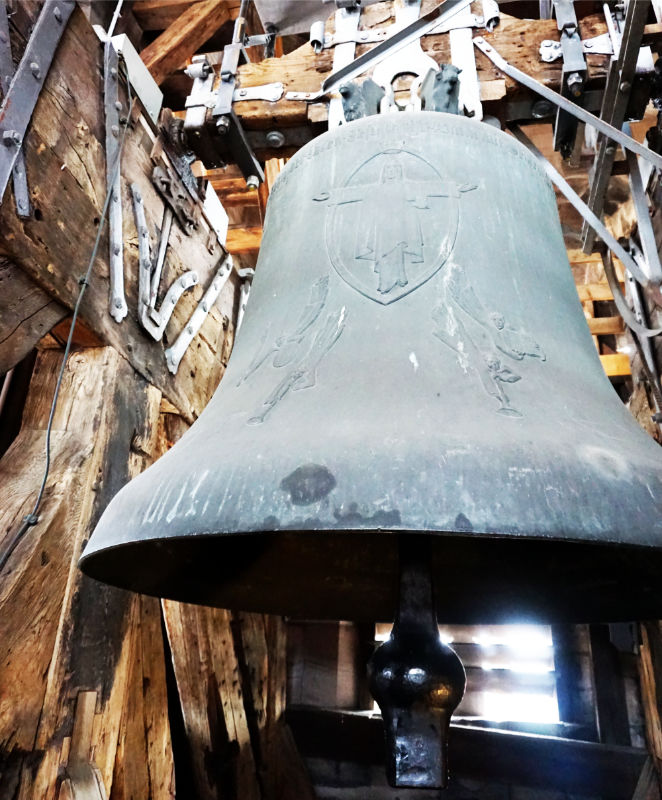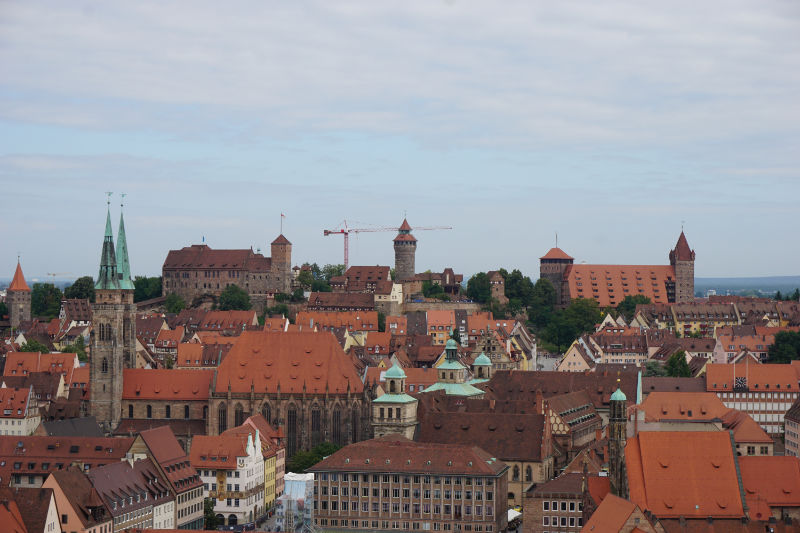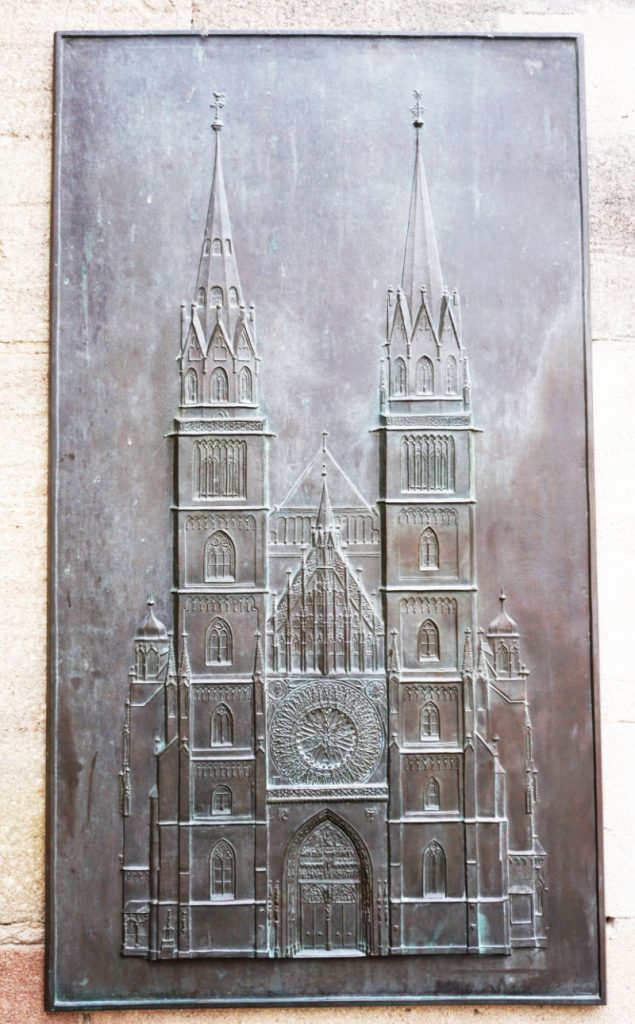The Lorenzkirche (Lorenz Church) is one of the most beautiful churches in Nuremberg. Its landmark, the St. Lorenz Star, can be seen from afar when walking towards the western facade. This stone rosette characterises the facade and the look of the church.

We have very mixed feelings about visiting churches on our trips. We have seen some stunning churches in the past but also some that were just a bit meh. In the past, we had used audioguides for tours of churches, if anything. This is why we were so curious when we began our guided tour in this one. Our guide was Frau Bammessel. She is responsible for pastoral care for tourists and guests of the Lorenzkirche.
To be honest, this tour put me off using audioguides again. Discovering a place like that through face to face interaction with a guide is just so much more enjoyable. The interaction and the real emotions brought the building to life and I took away so much knowledge and enthusiasm that my head was buzzing long after the tour had ended.
This post will not nearly do everything justice that we heard and saw in the church.
The Lorenzkirche
Our tour began with a little historical digression. We were told a lot about the history and construction of the church. I will only briefly touch on that as there are better-suited sources out there to learn about dates, construction work and master builders. Noteworthy is that the Lorenz church was erected in a spot where an old Romanesque chapel used to stand. This chapel was dedicated to Holy St. Lorenz and the Holy Grave.
Construction of the new basilica started in 1243. The citizens of Nuremberg supported the endeavour with substantial donations so that a representative church could be built. The eagerness of the locals to donate was fanned by a competition between two communities. The St. Lorenz parish and the neighbouring St. Sebald parish were building their churches at roughly the same time. The St. Sebald church is a little older (construction began in 1230). Each parish discovered details about the other communities church that they then wanted to include in their own as well. And to realise that, each parish reached deep into their wallets for an even more beautiful church.
The Lorenz church has three naves, two towers and a high middle roof. After influential families from the parish had claimed their own private chapels within the church, the exterior walls of the church had to be moved to expand the space inside.
The neighbouring St. Sebald parish had one big advantage over the St. Lorenz parish. They had the grave of the city’s patron St. Sebaldus which attracted many visitors to the church that brought additional donations. The St. Lorenz parish started promoting the remains of the Holy Deocarus, father confessor of Karl the Great. This strategic move was successful and more pilgrims started coming to the Lorenz church.
This also served as a valid argument to expand the church. A new choir was built around the old choir, bigger and brighter than before (1439 – 1477). The colourful windows make the church look light and friendly. Many artists contributed to the decoration of the church. Some pieces were particularly impressive like the 19 meters high tabernacle by mason Adam Kraft (built 1493 – 1496), the wonderful windows and the limewood piece „Angelic Salutation“ by Veit Stoß (built 1517/18).

At the very beginning of the Second World War, many artefacts and the lovely windows of the church were transported to safety in the art bunkers below Nuremberg. The tabernacle could not be moved so it was surrounded by a concrete cover for protection. The church was indeed hit by several bombs and damaged. By the end of the war, all that was left standing was a ruin. A lot of time and money was invested to reconstruct the Lorenzkirche so that by 1952 the first post-war service could be held here again. Restauration is still ongoing in some areas of the church.
Tour of the tower
Next, the tour of the tower started. We entered an area that is only accessible as part of guided tours through a small door in the nave.

We climbed the stairs of the tower until we reached the first two of its 16 bells. We were grateful that the mechanism that rings the bells was turned off beforehand. The bells were directly above us and to be honest, I do not want to be here when they ring. However, we were allowed to ring them manually with a little mallet and the sound was magnificent!
We continued to the balcony of the tower. The view of the city is beautiful from up here. But we weren’t here for just the view. We were also told a lot about the newer and older history of the city.

I also got to know two things that were completely new to me. They were about the gargoyles of churches and also about the medieval fire warning system. The stone dogs and chimaeras have a heated wire in their mouths that is activated in winter to prevent the forming of dangerous icicles.

The fire alarm system relied on the watchman on the tower. When he spotted a fire in the city he rang the fire bell. In order for the citizens to be able to put out the fire, they had to know where it was. To achieve that, there was a mount for a flag that could be rotated on every corner of the tower. The flag was pointed directly at the fire so that the citizens were able to locate it. The towers of St. Lorenz and St. Sebald worked together very precisely and prevented many major fires.

After the wonderful view from the tower, we continued our tour inside the church. We left the tower through a little door and found ourselves in the truss of the nave. An intricate framework formed the churches truss. We faced an elongated room that we crossed on designated planks. It was very interesting to see that up here is a mechanism to hang a massive chandelier that can be seen in the nave of the church. The chandelier can be lowered via a wheel.

We continued through another door into the truss of the choir. What a sight that was! An enormous truss raises almost 30 meters from the nave. These dimensions are far less obvious from ground level.
A path leads us across the truss. There was another big wheel here, too. This one to lower the Angelic Salutation in the nave. I was fascinated by the beams of the arched ceiling. Seeing them from above makes them look much more fragile than their massive appearance from below would suggest. Almost as if they would crack when someone walked on them.

A little staircase led from the truss back down to the church. About halfway down we stopped at another balcony and had a look down to the ground level. This, too, helped to make us aware of the impressive height of the choir. Back down in the church, I was overwhelmed by all the impressions from the different parts of the tour. I have never experienced a church like that I and would recommend this type of tour to anyone. A massive thanks to Frau Bammessel, who walked us through the church so wonderfully and to Stefanie Thielmann from the travel blog travel-moto.de, who had organised the tour.
Address:
Lorenzkirche
Lorenzplatz 1
90402 Nürnberg
Innenstadtpfarramt
Burgstraße 1 – 3
90403 Nürnberg
Pastor Susanne Bammessel
Gäste- und Touristenseelsorge St. Lorenz
Burgstraße 1 – 3
90403 Nürnberg
Telephone: 0911/ 24469914
Fax: 0911/24469924
E-Mail: [email protected]
https://www.lorenzkirche.de/
Opening Hours:
Monday to Saturday: 09.00 – 17.00
Sunday: 13.00 – 16.00
No tours during services
Tours:
Monday to Saturday: 11.00 and 14.00
Sunday and on Bank Holidays: 14.00
Tower tours:
May to October: Saturday 14.00
Admission:
Church interior:
Donations are welcome
Adults: 2€
Children: 1€
Tour:
Donations are welcome
Tower tour (15 participants maximum):
Adults: 5€
Children: 2€
Pictures from the interior of the church are used with the kind permission of pastor Susanne Bammessel.

















Leave a Reply